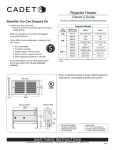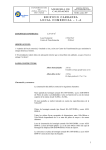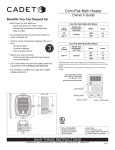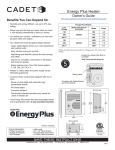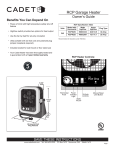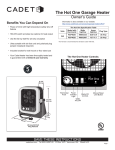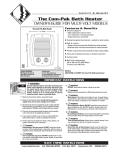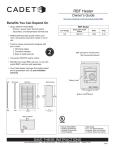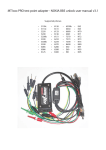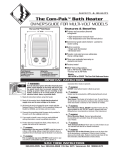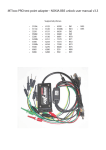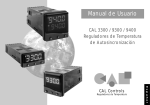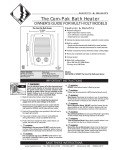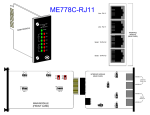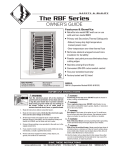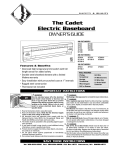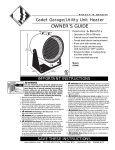Download Cadet RM151 User's Manual
Transcript
The Register Plus OWNER’S GUIDE Features & Benefits Grill Front Thermal Safeguard: • High temperature manual reset: turns off heater if normal operating temperatures are exceeded ■ Commercial grade steel element ■ Powder coat paint process eliminates sharp cutting edges ■ Five year extended warranty ■ Wall can designed for ease of installation ■ Optional double pole field mount thermostat kit available ■ Factory tested ■ Wall Can Front Wall Can Side 4"T 10,16 2"T 5,08 3/4"T 1,91 5 7/8"T T 14,92 1"T 2,54 2"T 5,08 Tools Required: Phillips Screwdriver Straight Screwdriver Wire Strippers 45˚T 3 3/8"T Dimensions in 8,57 inches (cm) 1"T 2,54 2 1/2"T 6,35 MODELS: RM202 RM208 RM108 RM151 RM162 Utility Knife (4) 1 ½“ Wood Screws (3) Insulated Wire Connectors (1) Strain Relief Connector Note: Thermostat not included IMPORTANT INSTRUCTIONS WARNING 7. Turn the electrical power off at the electrical panel board (circuit breaker or fuse box) and lock or tag the panel board door to prevent someone from turning on power while you are working on the heater. Failure to do so could result in serious electrical shock, burns, or possible death. 1. Read all instructions before using this heater. 2. Read all information labels. Verify that the electrical supply wires are the same voltage as the heater. 3. All electrical work and materials must comply with the National Electric Code (NEC), the Occupational Safety and Health Act (OSHA), and all state and local codes. 4. Connect the grounding pigtail (copper wire) provided in the wall can to the supply ground wire. 5. If you need to install a new circuit or need additional wiring information, consult a qualified electrician. 6. Protect electrical supply from kinks, sharp objects, oil, grease, hot surfaces or chemicals. WARNING Overheating or fire may occur. DO NOT install the heater in a floor, ceiling or behind doors. 8. WARNING Fire or explosion may occur. DO NOT install heater in any area where combustible vapors, gases, liquids, or excessive lint or dust are present. 9. WARNING Burn Hazard. This heater is hot when in use. To avoid burns, do not let bare skin touch hot surfaces. Use extreme caution when any heater is used by or near children or invalids. 10. WARNING Risk of Electrical Shock. Connect grounding lead to grounding wire provided. Keep all foreign objects out of heater. 11. WARNING Risk of Fire. Do not block heater. Heater must be kept clear of all obstructions: a minimum of 3 feet in front, 6 inches above and on both sides. Heaters must be kept clean of lint, dirt and debris. (See Maintenance Instructions). 12. Use this heater only as described in this manual. Any other use not recommended by the manufacturer may cause fire, electrical shock, or injury to persons. SAVE THESE INSTRUCTIONS TEL: 360-693-2505 Fax: 360-694-8668 P.O. Box 1675 Vancouver, WA 98668-1675 READ ALL INSTRUCTIONS AND SAFETY INFORMATION Installation Instructions Part One PLACEMENT: For best results install The Register Plus on an inside wall. Headers and bracing are not necessary. NOTE: The wall can must be installed in the TOP UP (horizontal) position only. Heater is not approved for ceiling mount. THERMOSTAT: A thermostat is required. A Cadet Electronic Thermostat is recommended for ultimate control and comfort. IMPORTANT! It is extremely important you verify the electrical supply wires are the same voltage as the heater (i.e. 120 volt heater to 120 volt power supply and 240 volt heater to 240 volt power supply). If replacing an existing heater, check the labels of the old heater and replace using the same voltage. Hooking a 240 volt heater to a 120 volt power supply will drastically reduce the heater's output. Hooking a 120 volt heater to a 240 volt power supply will destroy the heater. Connecting your heater to an incompatible power supply will void the warranty. How do I install for new construction? STEP 1 STEP 1 Mount Wall Can The RM series REQUIRES A MINIMUM distance of 6 inches from adjacent surfaces and 4 ½ inches from the floor. However, Cadet RECOMMENDS 12 inches from all adjacent surfaces and 12 inches from the floor (See Figure 5) for longer and cleaner performance. Heaters must be spaced at least 3 feet apart. Secure the wall can to the studs and/or sill plate with screws through the larger (3/16 inch) holes. (See Figures 1 and 2). Cut Hole In Wall Cut a hole 12 ¾ inches wide by 6 inches high next to wall stud. The RM series REQUIRES A MINIMUM distance of 6 inches from adjacent surfaces and 4 ½ inches from the floor. However, Cadet RECOMMENDS 12 inches from all adjacent surfaces and 12 inches from the floor (See Figure 5) for longer and cleaner performance. Heaters must be spaced at least 3 feet apart. FIGURE 1 Metal legs position wall can at minimum floor clearance. FIGURE 2 Bend one leg 90 degrees for higher placement and secure to studs. FIGURE 3 Face of wall can must extend ½ inch or 5/8 inch from face of stud to allow for thickness of sheetrock. Mount wall can flush with finished surface. STEP 2 FIGURE 5 STEP 2 Route Supply Wires Route supply wire from circuit breaker to wall thermostat, then to wall can. Remove a knockout and attach the supply wire with a strain relief connector leaving 10 inches wire lead for later use (See Figure 4). Connect supply ground wire to grounding pigtail in wall can. STEP 3 Mount Wall Can FIGURE 6 Insert wall can, legs first, into opening and rotate into wall. Route Supply Wires Route supply wire from circuit breaker to thermostat to wall can. Remove a knockout and attach the supply wire with a strain relief connector leaving 10 inches wire lead for later use. Connect supply ground wire to grounding pigtail in wall can (See Figure 4). Proceed to PART TWO. KNOCK-OUT (TWIST TO REMOVE) STRAIN RELIEF CONNECTOR GROUNDING WIRE WIRE CONNECTOR FIGURE 7 Keeping front of wall can flush with finished surface, secure to wall stud with screws through larger (3/16 inch) holes. FIGURE 4 SUPPLY WIRE Warranty is void if any material is sprayed on the element or blower. How do I install in an existing wall? GROUNDING PIGTAIL IMPORTANT: Insert two drywall screws into the small holes opposite the wall stud into the drywall to rest against backside of sheetrock (keeping wall can flush to wall). Proceed to PART TWO. Installation Instructions Part Two STEP 1 If you are installing a Multi-Watt heater, model numbers RM151 or RM162, begin with STEP 2 below. If you are installing an RM202, RM208, or RM108, begin with STEP 3 below. STEP 2 Element Wire Configuration (Multi-watt models RM151 or RM162 only) Cadet’s Multi-Watt RM heater offers a variety of heat output options. You must first determine the desired wattage and then configure the heating element wire connections. The heater is shipped from the factory configured for 1600 Watts (240V) or 1200 Watts (208V) for RM162, and 1500 Watts (120V) for RM151. If this is the wattage you desire, proceed to STEP 3. WARNING Risk of Electrical Shock. Connect grounding lead to grounding wire provided. Keep all foreign objects out of heater. On models RM151 and RM162, mark the wiring diagram on the back of the heater with the wattage used for future reference. FIGURE 1 RM Wiring Table VOLTAGE IF YOUR DESIRED WATTAGE IS: RM162 240V 1600 900 700 RM162 208V 1200 675 528 RM151 120V 1500 1000 500 MODEL YOUR WIRES WILL BE CONFIGURED LIKE THIS: Upper Element A Lower Element C 900W-240V 700W-240V Yellow Terminal X Blue Terminal Z Yellow Terminal X None (*) None (*) Yellow Terminal X 675W-208V 525W-208V Yellow Terminal Yellow Terminal None (*) 1000W-120V Yellow Terminal Yellow Terminal None (*) X X X X Blue Terminal Z None (*) Yellow Terminal X 500W-120V Blue Terminal Z None (*) Yellow Terminal X *Cut Blue Terminal from Red Wire and wrap with electrical tape. Yellow Terminal Y remains connected at B . Do Not Touch. WARNING Risk of Fire. Heater must be kept clear of all obstructions: a minimum of 3 feet in front; 6 inches on both sides and above. Heaters must be kept clean of lint, dirt and debris. 675W-208V 900W-240V 1000W-120V 525W-208V 700W-240V 500W-120V MANUAL RESET HIGH TEMP CUTOFF Motor End View Heater Element Locations STEP 3 Install Heater Assembly Set the heater assembly (blower wheel first) into the left side of the wall can. Fasten at top with screw provided. Unlace heater lead wires. Connect the supply wires to the heater wires (See Figure 2). Keep all wires away from element connections when wires are pushed into free space on right of heater. FIGURE 2 Fasten screw Supply leads Blower wheel STEP 4 Install Grill Secure grill with the screws provided. Turn power on at the electrical panel board. Manual reset button Heater leads Grounding Pigtail WARNING Turn the electrical power off at the electrical panel board (circuit breaker or fuse box) and lock or tag the panel board door to prevent someone from turning on power while you are working on the heater. Failure to do so could result in serious electrical shock, burns, or possible death. Operation & Maintenance How to operate your heater 1. Once installation is complete and power has been restored, turn the thermostat knob fully clockwise. 2. When the room reaches your comfort level, turn the thermostat knob counterclockwise until the heater turns off. The heater will automatically cycle around this preset temperature. 3. To reduce the room temperature, turn the knob counterclockwise. To increase the room temperature, turn the knob clockwise. Maintenance As needed, or every six months, minimum. 1. WARNING! Before removing grill, turn the electrical power off at the electrical panel board (circuit breaker or fuse box). Lock or tag the panel board door to prevent someone from accidentally turning the power on while you are working on the heater. Failure to do so could result in serious electrical shock, burns, or possible death. 2. It is important that you verify power has been turned off and no power is going to the heater before proceeding. Circuit breakers are often not marked correctly and turning the wrong breaker off could mean electricity is flowing to the heater, even if the heater does not appear to be working. If you are uncomfortable working with electrical appliances, unable to follow these guidelines, or do not have the necessary equipment, consult a qualified electrician. 3. Once you verify the power has been turned off correctly, proceed to the next step. 4. Remove screws and take off grill. 5. Wash grill with hot soapy water and dry immediately. 6. While holding blower wheel (to avoid damage or bending), use a hair dryer or vacuum on blow cycle to blow debris through the element (Do not touch element). 7. Vacuum blower area without touching the elements. 8. Replace grill and secure with screws. 9. Turn thermostat to desired setting. 10. Turn power back on at the electrical panel board. About the Manual Reset Temperature Limit Control The heater is protected by a temperature-limiting control. The manual reset temperature limit control is designed to open the heater circuit when excessive operating temperatures are detected. The problem must be assessed and the limit must be reset to resume operation. Resetting the Manual Reset Temperature Limit Control If the manual-reset limit control has opened the heater circuit due to excessive operating temperatures, the heater will not work until the manual reset limit button is pressed. After allowing the unit to cool for at least 10 minutes and resolving the problem causing the limit to trip; use a narrow object such as a ball-point pen to access the manual reset button through the lower-right center section of the heater grill. Press FIRMLY and be sure to listen and feel for a click, indicating it has been reset. Troubleshooting Chart CONSULT LOCAL ELECTRICAL CODES TO DETERMINE WHAT WORK MUST BE PERFORMED BY QUALIFIED ELECTRICAL SERVICE PERSONNEL Symptom Problem Solution Breaker trips immediately upon energizing heater. 1. Incorrect supply voltage. 2. Overloaded circuit. 1. Verify that supply voltage matches the heater rating. 2. The total amperage of all heaters on a branch circuit must not be more than 80% of the amperage rating of the circuit breaker and supply wire ratings. Use a lower wattage heater, or reduce the number of heaters on the circuit. 3. Shorted supply or heater wires may be accompanied by severe sparking. Inspect all supply and heater wiring insulation for damage. Do not reset the circuit breaker until all electrical shorts have been repaired. 4. Replace the circuit breaker. 1. Allow a few moments for element to reach operating temperature. 2. Verify that supply voltage matches the heater rating. 3. Replace element. 1. Close doors and windows. Provide additional insulation or install a higher-wattage heater or multiple heaters if necessary (if your circuit is rated for more capacity). 2. Adjust thermostat to its lowest setting. If heater continues to run (allow two minutes for the thermostat to respond), and room temperature is greater than 50 degrees; replace thermostat. 3. Refer to thermostat documentation and correct wiring. 1. Clean heater (see “Operation & Maintenance” section for instructions). 3. A short circuit exists in the supply or heater wiring. Heater fan operates, but does not discharge warm air. Heater will not shut off. 4. Defective circuit breaker. 1. Insufficient element temperature. 2. Incorrect supply voltage. 3. Element has failed. 1. Heat loss from room is greater than heater capacity. 2. Defective thermostat. Heater discharges smoke or emits a burnt odor. Element heats for a moment without the fan turning, then immediately stops heating. Heater does not run. 3. Thermostat wired incorrectly to heater. 1. Dust, lint or other matter has accumulated inside heater. 1. Defective motor or internal connection. 2. Fan or motor jammed. 1. Thermostat set too low. 2. Heater has tripped the manual reset temperature limit control. 3. Power not on at the circuit breaker. 4. Broken or poorly connected wire(s) to heater. 5. Defective thermostat. Heater continually trips the manual reset temperature limit control. 1. Dust, lint or other matter has accumulated inside heater. 2. Airflow is blocked. 3. Fan or motor is jammed. 4. None of the above. 1. Heater or fan motor requires replacement. 2. Remove obstruction, and press heater manual reset button (see “Operation & Maintenance” section for instructions). 1. Adjust thermostat to a higher temperature until heater operates (see Problem #6 if the problem persists). 2. Press the manual reset button (see “Operation & Maintenance” section for instructions). 3. Turn on the correct circuit breaker in the main panel. 4. Turn off power at circuit breaker. Check supply wire continuity and proper connection to heater wires. 5. The entire heater, or any of its components may be checked for continuity to determine the cause of any problem. Repair or replace the heater. 1. Clean heater (see “Operation & Maintenance” section for instructions.) 2. Remove obstruction. Maintain a minimum distance of 6 inches from adjacent surfaces, 4.5 inches from the floor, and 3 feet for furniture or other objects placed directly in front of the heater. 3. Remove obstruction, and press heater manual reset button (see “Operation & Maintenance” section for instructions). 4. Replace heater assembly. Warranty Maintenance: For more effective and safer operation and to prolong the life of the heater, read the Owner’s Guide and follow the maintenance instructions included with each heater. Failure to properly maintain the heater will void any warranty and may cause the heater to function improperly. Warranties are non transferable and apply to original consumer only. Warranty terms are set out below. LIMITED ONE-YEAR WARRANTY: Cadet will repair or replace any Cadet product, including thermostats, found to be defective within one year after the date of purchase. Extended Product Warranty LIMITED FIVE-YEAR WARRANTY: Cadet will repair or replace any Register Plus (RM) series element or motor found to be defective or malfunctioning from first date of purchase through the fifth year. THESE WARRANTIES DO NOT APPLY: 1. Damage occurs to the product through improper installation or incorrect supply voltage; 2. Damage occurs to the product through improper maintenance, misuse, abuse, accident, or alteration; 3. The product is serviced by anyone other than Cadet. 4. If the date of manufacture of the product cannot be determined; 5. If the product is damaged during shipping through no fault of Cadet. 6. CADET’S WARRANTY IS LIMITED TO REPAIR OR REPLACEMENT AS SET OUT HEREIN. CADET SHALL NOT BE LIABLE FOR DAMAGES SUCH AS PROPERTY DAMAGE OR FOR CONSEQUENTIAL DAMAGES AND/OR INCIDENTAL EXPENSES RESULTING FROM BREACH OF THESE WRITTEN WARRANTIES OR ANY EXPRESS OR IMPLIED WARRANTY. 7. IN THE EVENT CADET ELECTS TO REPLACE ANY PART OF YOUR CADET PRODUCT, THE REPLACEMENT PARTS ARE SUBJECT TO THE SAME WARRANTIES AS THE PRODUCT. THE INSTALLATION OF REPLACEMENT PARTS DOES NOT MODIFY OR EXTEND THE UNDERLYING WARRANTIES. REPLACEMENT OR REPAIR OF ANY CADET PRODUCT OR PART DOES NOT CREATE ANY NEW WARRANTIES. 8. These warranties give you specific legal rights, and you may also have other rights which vary from state to state. Cadet neither assumes, nor authorizes anyone to assume for it, any other obligation or liability in connection with its products other than as set out herein. If you believe your Cadet product is defective, please contact Cadet Manufacturing Co. at 360-693-2505, during the warranty period, for instructions on how to have the repair or replacement processed. Warranty claims made after the warranty period has expired will be denied. Products returned without authorization will be refused. Parts and Service Visit http://support.cadetco.com for information on where to obtain parts and service. Reduce-Reuse-Recycle This product is made primarily of recyclable materials. You can reduce your carbon footprint by recycling this product at the end of its useful life. Contact your local recycling support center for further recycling instructions. ©2009 Cadet Manufacturing Co. Printed in U.S.A. Rev. 6/09 #720104 The Register Plus GUÍA PARA EL PROPIETARIO Características y Beneficios Parte delantera de la rejilla ■ Parte delantera de la cámara de pared Lado de la cámara de pared 4"T 10,16 2"T 5,08 3/4"T 1,91 5 7/8"T T 14,92 1"T 2,54 2"T 5,08 Herramientas necesarias: Destornillador Phillips Destornillador plano Pelacables 45˚T 3 3/8"T Dimensions in 8,57 inches (cm) 1"T 2,54 2 1/2"T 6,35 Cuchillo multiuso (4) tornillos de 1½” para madera (3) conectores de alambre aislados (1) conector de alivio de tensión Protección térmica: • Reglaje manual de alta temperatura: apaga el calentador si se sobrepasan las temperaturas de operación normales ■ Elemento de acero de calidad comercial ■ Proceso de pintado con cobertura pulverizada que elimina los bordes filosos cortantes ■ Garantía extendida de cinco años ■ Cámara de pared diseñada para facilitar la instalación ■ Se ofrece juego de termostato opcional de doble polo para montaje en terreno ■ Probado en fábrica MODELOS: RM202 RM208 RM108 RM151 RM162 Nota: Termostato no incluido INSTRUCCIONES IMPORTANTES ADVERTENCIA Desconecte la electricidad en el tablero del panel eléctrico (caja de cortacircuitos o fusibles) y trabe o coloque un cartel en la puerta del tablero del panel para evitar que alguien vuelva a conectar la energía mientras se esté trabajando en el calentador. De lo contrario podrían producirse graves golpes eléctricos, quemaduras e incluso la muerte. 1. Lea todas las instrucciones antes de usar este calentador. 2. Lea todas las etiquetas que contengan información. Verifique que todos los cables de suministro eléctrico sean del mismo voltaje que el calentador. 3. Todo trabajo y materiales eléctricos deben cumplir con el Código Eléctrico Nacional (“NEC”, por su sigla en inglés), con la Ley de Seguridad y Salud Ocupacional (“OSHA”, por su sigla en inglés) y con todos los códigos estatales y locales. 4. Conecte el cable en espiral (de cobre) de puesta a tierra que viene en la cámara de pared al cable de conexión a tierra de suministro. 5. Si se debe instalar un nuevo circuito o se necesita información adicional sobre el cableado, consulte a un electricista calificado. 6. Evite que los cables de suministro eléctrico se retuerzan o entren en contacto con objetos afilados, aceite, grasa, superficies calientes o sustancias químicas. 7. ADVERTENCIA Podría producirse sobrecalentamiento o un incendio. NO instale el calentador en el suelo, cielo raso o detrás de puertas. 8. ADVERTENCIA Podrían producirse explosiones o incendios. NO instale el calentador en áreas donde exista la presencia de vapores, gases o líquidos combustibles o exceso de pelusas o polvo. 9. ADVERTENCIA Riesgo de quemaduras. Este calentador se calienta mucho cuando está en uso. Para evitar quemaduras, no lo toque con su piel descubierta. Tenga mucho cuidado al utilizar cualquier tipo de calentador en presencia de niños o personas inválidas. 10. ADVERTENCIA Riesgo de electrocución. Conecte el conductor a tierra al cable de puesta a tierra provisto. Evite que entren objetos extraños al calentador. 11. ADVERTENCIA Riesgo de incendio. No bloquee el calentador. El calentador debe mantenerse sin obstrucciones: un mínimo de 3 pies por delante, 6 pulgadas por encima y en cada costado. Los calentadores deben mantenerse sin pelusas, suciedad ni residuos. (Consulte las instrucciones de mantenimiento). 12. Use este calentador sólo como se describe en este manual. Todo otro uso no recomendado por el fabricante puede causar incendios, descargas eléctricas o lesiones personales. CONSERVE ESTAS INSTRUCCIONES TEL: 360-693-2505 Fax: 360-694-8668 P.O. Box 1675 Vancouver, WA 98668-1675 LEA TODAS LAS INSTRUCCIONES E INFORMACIÓN ACERCA DE LA SEGURIDAD ¡IMPORTANTE! Es extremadamente importante verificar que los cables de suministro eléctrico sean del mismo voltaje que el calentador (es decir, un calentador de 120 voltios con un suministro de energía de 120 voltios y un calentador de 240 voltios con un suministro de energía de 240 voltios). Si va a reemplazar un calentador existente, revise las etiquetas del calentador antiguo y sustitúyalo por otro del mismo voltaje. Si se conecta un calentador de 240 voltios a un suministro de energía de 120 voltios, se reducirá drásticamente el rendimiento del calentador. Si se conecta un calentador de 120 voltios a un suministro de energía de 240 voltios, se destruirá el calentador. Si se conecta el calentador a un suministro de energía incompatible, se anulará la garantía. La garantía pierde su validez si se rocía algún producto en el elemento o en el soplador. Instrucciones para la instalación Parte Uno UBICACIÓN: Para obtener mejores resultados, instale el calentador Register Plus en una pared interior. No se necesitan brochales ni soportes. NOTA: La cámara de pared debe instalarse sólo con la parte superior hacia arriba (posición horizontal). No se ha aprobado el uso del calentador para montaje en cielo raso. TERMOSTATO: Se requiere un termostato. Se recomienda usar un termostato electrónico Cadet para una comodidad y un control óptimos. ¿Cómo se instala el calentador en una construcción nueva? PASO 1 Montaje de la cámara de pared ¿Cómo se instala el calentador en una pared existente? PASO 1 Corte un orificio en la pared La serie RM REQUIERE una distancia mínima de 6 pulgadas de las superficies adyacentes y 4½ pulgadas desde el piso. Sin embargo, Cadet RECOMIENDA 12 pulgadas de distancia de todas las superficies adyacentes y 12 pulgadas del piso (vea la figura 5) para una vida útil más larga y un funcionamiento más limpio. Si se instalan varios calentadores, deje al menos tres pies entre ellos. Corte un orificio de 12¾ pulgadas de ancho por 6 de alto al lado del puntal de la pared. La serie RM REQUIERE una distancia mínima de 6 pulgadas de las superficies adyacentes y 4½ pulgadas del piso. Sin embargo, Cadet RECOMIENDA 12 pulgadas de distancia de todas las superficies adyacentes y 12 pulgadas del piso (vea la figura 5) para una vida útil más larga y un funcionamiento más limpio. Si se instalan varios calentadores, deje al menos tres pies entre ellos. Fije la cámara de pared a los puntales y/o el larguero mediante tornillos a través de los orificios más grandes (3 /16 de pulgada). (Consulte las figuras 1 y 2). FIGURA 1 Las patas metálicas posicionan la cámara de pared de modo que quede el espacio mínimo entre ésta y el piso. FIGURA 2 Doble una pata en 90 grados para una instalación a mayor altura y fíjela a los puntales. FIGURA 3 La superficie de la cámara de pared debe sobresalir entre 1/2 pulgada y 5/8 de pulgada de la superficie del puntal a fin de dejar espacio para la lámina de yeso. Monte la cámara de pared a ras con la superficie acabada. PASO 2 Instalación de los cables de suministro Dirija el cable de suministro desde el cortacircuito al termostato y a la cámara de pared. Quite un destapadero y coloque el cable de suministro mediante un conector de alivio de tensión dejando 10 pulgadas de cable de conexión para utilizarlo más adelante. Conecte el alambre de suministro a tierra al cable espiral de puesta a tierra situado en la cámara de pared (consulte la figura 4). Continúe con la PARTE DOS. FIGURA 4 FIGURA 5 PASO 2 Instalación de los cables de suministro Dirija el cable de suministro desde el cortacircuito al termostato mural y luego a la cámara de pared. Quite un destapadero y fije el cable de suministro mediante un conector de alivio de tensión dejando 10 pulgadas de cable de conexión para utilizarlo más adelante (consulte la figura 4). Conecte el cable de puesta a tierra de suministro al cable en espiral de conexión a tierra situado en la cámara de pared. PASO 3 Montaje de la cámara de pared FIGURA 6 Inserte la cámara de pared, con las patas por delante, en la abertura y gírela para introducirla en la pared. FIGURA 7 Manteniendo la parte delantera de la cámara al ras con la superficie acabada, fije la cámara al puntal con 2 tornillos a través de los cuatro orificios grandes (de 3/16 de pulgada). IMPORTANTE: Coloque dos tornillos para paredes de yeso en los orificios pequeños en frente del puntal de la pared de yeso a fin de apoyar el calentador en la parte posterior de la lámina (manteniendo la cámara al ras con la pared). Continúe con la PARTE DOS. Instrucciones para la instalación Parte Dos PASO 1 Si va a instalar un calentador de vatiaje múltiple, números de modelo RM151 o RM162, comience por el PASO 2 a continuación. Si va a instalar un RM202, RM208 o RM108, comience por el PASO 3 a continuación. PASO 2 Configuración de alambres del elemento (sólo modelos de vatiaje múltiple RM151 o RM162) El calentador Cadet RM de vatiaje múltiple ofrece una gran variedad de opciones de generación de calor. Primero debe determinar el vatiaje deseado y luego configurar las conexiones de alambres del elemento calentador. El calentador viene configurado de fábrica para 1600 vatios (240 V) o 1200 vatios (208 V) en el caso del modelo RM162, y 1500 vatios (120 V) en el caso del RM151. Si éste es el vatiaje que desea, proceda con el PASO 3. Como referencia futura para los modelos RM151 y RM162, anote el vatiaje utilizado en el diagrama de cableado situado en la parte posterior del calentador. ADVERTENCIA Riesgo de electrocución. Conecte el conductor a tierra al cable de puesta a tierra provisto. Evite que entren objetos extraños al calentador. FIGURA 1 Tabla de cableado del modelo RM MODELO VOLTAJE SI EL VATIAJE QUE DESEA ES: RM162 240V 1600 900 700 RM162 208V 1200 675 528 RM151 120V 1500 1000 500 LOS ALAMBRES SE DEBEN CONFIGURAR ASÍ: Elemento superior A Elemento inferior C 900W-240V 700W-240V Terminal amarillo X Terminal azul Z Terminal amarillo X Ninguno (*) Ninguno (*) Terminal amarillo X 675W-208V 525W-208V Terminal amarillo Terminal amarillo Ninguno (*) 1000W-120V Terminal amarillo Terminal amarillo Ninguno (*) X X X X Terminal azul Z Ninguno (*) Terminal amarillo X 500W-120V Terminal azul Z Ninguno (*) Terminal amarillo X *Corte el terminal azul del alambre rojo y cúbralo con cinta para uso eléctrico. El terminal Y permanece conectado a B . No lo toque. 675W-208V 900W-240V 1000W-120V 525W-208V 700W-240V 500W-120V Vista extrema del motor, ubicaciones del elemento calentador PASO 3 Instale la unidad del calentador Instale el conjunto del calentador (rueda del soplador primero) en el costado izquierdo de la cámara de pared. Afiáncelo en la parte superior con el tornillo que se proporciona. Desamarre los alambres conductores del calentador. Conecte los alambres de suministro con los del calentador (consulte la figura 2). Mantenga todos los alambres lejos de las conexiones del elemento al introducirlos en el espacio libre a la derecha del calentador. PASO 4 Instale la rejilla Fije la rejilla con los tornillos suministrados. Conecte la alimentación en el tablero del panel eléctrico. FIGURA 2 Apriete el tornillo Conductores de suministro Rueda del soplador Botón de reglaje manual Conductores del calentador Cable en espiral de puesta a tierra ADVERTENCIA Riesgo de incendio. El calentador debe mantenerse sin obstrucciones: un mínimo de 3 pies por delante, 6 pulgadas en cada costado y por encima. Los calentadores deben mantenerse sin pelusas, suciedad ni residuos. ADVERTENCIA Desconecte la electricidad en el tablero del panel eléctrico (caja de cortacircuitos o fusibles) y trabe o coloque un cartel en la puerta del tablero del panel para evitar que alguien vuelva a conectar la energía mientras se esté trabajando en el calentador. De lo contrario podrían producirse graves golpes eléctricos, quemaduras e incluso la muerte. Funcionamiento y mantenimiento Cómo hacer funcionar el calentador 1. Una vez que se haya realizado la instalación y reestablecido la energía eléctrica, gire totalmente la perilla del termostato en el sentido de las manecillas del reloj. 2. Cuando la habitación haya alcanzado un nivel cómodo, gire la perilla del termostato en sentido contrario a las manecillas del reloj hasta que el calentador se apague. El calentador se encenderá y apagará automáticamente según esta temperatura preestablecida. 3. Para reducir la temperatura del ambiente, gire la perilla en sentido contrario a las manecillas del reloj. Para aumentar la temperatura del ambiente, gire la perilla en el sentido de las manecillas del reloj. Mantenimiento Según sea necesario, o cada seis meses como mínimo. 1. ¡ADVERTENCIA! Antes de quitar la rejilla, desconecte la electricidad en el tablero del panel eléctrico (cortacircuito o caja de fusibles). Trabe o coloque un cartel en la puerta del tablero del panel para evitar que alguien conecte accidentalmente la energía mientras se esté trabajando en el calentador. De lo contrario podrían producirse graves golpes eléctricos, quemaduras e incluso la muerte. 2. Antes de proceder, es importante que usted verifique que se haya desconectado la alimentación y que el calentador no reciba energía. Los cortacircuitos no suelen estar correctamente marcados, y apagar el incorrecto podría significar que sigue fluyendo electricidad al calentador, aun cuando éste parezca no estar funcionando. Si no se siente cómodo al trabajar con artefactos eléctricos, no está en condiciones de acatar estas pautas o no cuenta con los equipos necesarios, solicite los servicios de un técnico electricista calificado. 3. Una vez que verifique que se ha apagado la alimentación correctamente, prosiga con el paso siguiente. 4. Retire los tornillos y extraiga la rejilla. 5. Lave la rejilla con agua caliente y jabón, y séquela de inmediato. 6. Mientras sujeta la rueda del soplador (para evitar que se dañe o tuerza), utilice una secadora o una aspiradora en el ciclo de soplado para quitar la suciedad en el elemento superior (sin tocarlo). 7. Aspire el área del soplador sin tocar los elementos. 8. Vuelva a instalar la rejilla y fíjela con los tornillos. 9. Coloque el termostato en la graduación deseada. 10. Vuelva a conectar la alimentación en el tablero del panel eléctrico. Acerca del control de límite de temperatura de reglaje manual El calentador está protegido por un control limitador de temperatura con reglaje manual, el cual está diseñado para abrir el circuito del calentador cuando se detectan temperaturas de funcionamiento excesivas. El problema debe evaluarse y el límite debe restablecerse para que el calentador vuelva a funcionar. Cómo restablecer el control limitador de temperatura de reglaje manual Si el control limitador de reglaje manual ha abierto el circuito del calentador debido a temperaturas de funcionamiento excesivas, el calentador no funcionará sino hasta que se oprima el botón de límite de reglaje manual. Después de dejar que la unidad se enfríe durante unos 10 minutos y resolver el problema que causa que se disyunte el interruptor de límite, utilice un objeto puntiagudo como un bolígrafo para acceder al botón de reglaje manual a través de la sección central inferior derecha de la rejilla del calentador. Oprima el botón FIRMEMENTE y asegúrese de escuchar y sentir un chasquido indicando que se ha restablecido. Tabla de resolución de problemas CONSULTE LOS CÓDIGOS ELÉCTRICOS LOCALES PARA DETERMINAR QUÉ TRABAJOS DEBEN SER REALIZADOS POR PERSONAL DE SERVICIO ELÉCTRICO CALIFICADO SÍNTOMA PROBLEMA El interruptor se disyunta inmediatamente al encenderse el calentador. 1.Voltaje de suministro incorrecto. 2. Circuito sobrecargado. SOLUCIÓN 1. Compruebe que el voltaje de suministro coincida con la calificación del calentador. 2. El amperaje total de todos los calentadores en un circuito de rama no debe sobrepasar el 80% de la calificación de amperaje del cortacircuito y de las calificaciones de los cables de suministro. Utilice un calentador de vatiaje inferior o reduzca la cantidad de calentadores en el circuito. 3. Hay un cortocircuito en los cables de suministro 3. Los cables de suministro o del calentador que presentan cortocircuitos pueden ocasionar o del calentador. chispas peligrosas. Revise el aislamiento de todos los cables de suministro y del calentador para comprobar que no estén dañados. No reestablezca el cortacircuito sino hasta que se hayan reparado todos los cortocircuitos eléctricos. 4. Cortacircuito defectuoso. 4. Reemplace el cortacircuito. El ventilador del calentador 1. Temperatura insuficiente del elemento. 1. Espere unos momentos para que el elemento alcance la temperatura de funcionamiento. funciona pero no envía 2. Voltaje de suministro incorrecto. 2. Compruebe que el voltaje de suministro coincida con la calificación del calentador. aire caliente. 3. El elemento ha fallado. 3. Reemplace el elemento. El calentador no se apaga. 1. La fuga de calor de la habitación es superior a la 1. Cierre las puertas y ventanas. Coloque aislamiento adicional o instale un calentador de mayor capacidad del calentador. vatiaje o múltiples calentadores si fuese necesario (si su circuito es apto para mayor capacidad). 2. Termostato defectuoso. 2. Ajuste el termostato a la graduación más baja. Si el calentador continúa funcionando (espere un par de minutos para que el termostato tenga tiempo de responder al ajuste) y la temperatura del ambiente es superior a 50 grados, reemplace el termostato. 3. Termostato cableado al calentador de forma incorrecta. 3. Consulte la documentación del termostato y cableado correcto. El calentador emite humo 1. Se han acumulado polvo, pelusas u otros 1. Limpie el calentador (consulte las instrucciones en la sección “Funcionamiento y Mantenimiento”). o un olor a quemado. materiales dentro del calentador. 1. Motor o conexión interna defectuosos. El elemento calienta por un 1. Debe reemplazarse el calentador o el motor del ventilador. momento sin que gire el venti- 2. Ventilador o motor trabado. 2. Retire la obstrucción y oprima el botón de reglaje manual del calentador (vea las instrucciones lador y luego deja de calentar. en la sección “Funcionamiento y Mantenimiento”). El calentador no funciona. 1. El termostato se ha graduado muy bajo. 1. Ajuste el termostato a una temperatura más alta hasta que el calentador funcione (vea el Problema No. 6 si la dificultad persiste). 2. El calentador ha disyuntado el control limitador 2. Oprima el botón de reglaje manual (vea las instrucciones en la sección “Funcionamiento y de temperatura de reglaje manual. Mantenimiento”). 3. La energía no está conectada en el cortacircuito. 3. Conecte el cortacircuito correcto en el panel principal. 4. El o los cables que van al calentador están rotos 4. Desconecte la energía en el cortacircuito. Revise la continuidad del cable de suministro y la o mal conectados. conexión apropiada a los cables del calentador. 5. Termostato defectuoso. 5. Se debe revisar la continuidad de todo el calentador, o bien de sus componentes a fin de determinar la causa de cualquier problema. Repare o reemplace el calentador. El calentador disyunta 1. Se han acumulado polvo, pelusas u otros 1. Limpie el calentador (vea las instrucciones en la sección “Funcionamiento y Mantenimiento”). continuamente el control materiales dentro del calentador. 2. Retire la obstrucción. Mantenga una distancia mínima de 6 pulgadas de las superficies adyacentes, limitador de temperatura 2. El flujo de aire está bloqueado. 4.5 pulgadas del piso y 3 pies de los muebles u otros objetos situados directamente delante de reglaje manual. del calentador. 3. El ventilador o el motor está trabado. 3. Retire la obstrucción y oprima el botón de reglaje manual del calentador (vea las instrucciones en la sección “Funcionamiento y Mantenimiento”). 4. Ninguna de las anteriores. 4. Reemplace el conjunto del calentador. Garantía Mantenimiento: Para lograr una operación más eficaz y segura y prolongar la vida útil del calentador, lea la Guía del propietario y siga las instrucciones de mantenimiento incluidas con cada unidad. Si no le da el mantenimiento adecuado al calentador invalidará la garantía y puede hacer que el aparato funcione incorrectamente. Las garantías no son transferibles y rigen sólo para el comprador original. Los términos de la garantía se indican a continuación. GARANTÍA LIMITADA DE UN AÑO: Cadet reparará o reemplazará todo producto Cadet, incluyendo los termostatos, que presente averías en un plazo de un año a partir de la fecha de compra. Garantía extendida del producto GARANTÍA LIMITADA DE CINCO AÑOS: Cadet reparará o reemplazará, durante tres años a partir de la fecha de compra, todo elemento o motor serie Register Plus (RM) que se determine que está averiado o funcionando mal. ESTAS GARANTÍAS NO SON PERTINENTES PARA: 1. Daños que sufra el producto por instalación o voltaje de suministro incorrectos; 2. Daños que sufra el producto por mantenimiento incorrecto, uso indebido, abuso, accidente o alteraciones; 3. Servicio que se le haya dado al producto por parte de personas o entidades ajenas a Cadet. 4. Casos en que no se pueda determinar la fecha de fabricación del producto; 5. Casos en que el producto resulte dañado durante el embarque por causas ajenas a Cadet. 6. LA GARANTÍA DE CADET SE LIMITA A LA REPARACIÓN O REEMPLAZO, TAL COMO SE ESTABLECE EN ESTE DOCUMENTO. CADET NO SE HARÁ RESPONSABLE POR DAÑOS A LA PROPIEDAD O DAÑOS CONSECUENTES, COMO TAMPOCO POR GASTOS ACCIDENTALES DEBIDO AL INCUMPLIMIENTO DE ESTAS GARANTÍAS ESCRITAS O DE CUALQUIER GARANTÍA EXPRESA O IMPLÍCITA. 7. EN CASO DE QUE CADET DECIDA REEMPLAZAR ALGUNA PIEZA DEL PRODUCTO CADET, LOS REPUESTOS SE REGIRÁN POR LAS MISMAS GARANTÍAS DEL PRODUCTO. LA INSTALACIÓN DE LOS REPUESTOS NO MODIFICA NI PROLONGA LAS GARANTÍAS VIGENTES. EL REEMPLAZO O REPARACIÓN DE TODO PRODUCTO O PIEZA CADET NO ORIGINA NINGÚN TIPO DE NUEVA GARANTÍA. 8. Estas garantías le otorgan derechos legales específicos y es posible que usted tenga otros derechos que varíen de un estado a otro. Cadet no asume ni autoriza a nadie que lo haga en su nombre, ninguna otra obligación o responsabilidad en relación con sus productos que no sean las que se establecen en este documento. Si durante el período de garantía usted considera que su producto Cadet presenta defectos, comuníquese con Cadet Manufacturing Co. llamando al 360-693-2505 para obtener instrucciones sobre cómo tramitar la reparación o el reemplazo del producto. Los reclamos de garantía presentados después de la finalización del período no serán acogidos. Los productos que se devuelvan sin autorización serán rechazados. Repuestos y servicio En http://support.cadetco.com encontrará información sobre dónde obtener repuestos y servicio. Reduzca-reutilice-recicle Este producto está hecho principalmente de materiales reciclables. Puede reducir la cantidad de carbono que contribuye al medio ambiente reciclando este producto al término de su vida útil. Comuníquese con su centro local de reciclaje para obtener mayores instrucciones al respecto. ©2009 Cadet Manufacturing Co. IMPRESO EN EE.UU. Rev. 7/09 #720104
This document in other languages
- español: Cadet Manufacturing 00307








